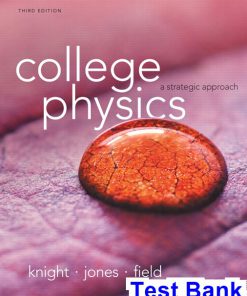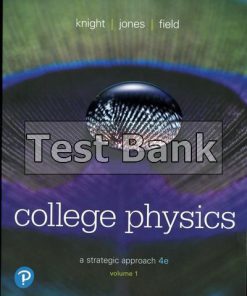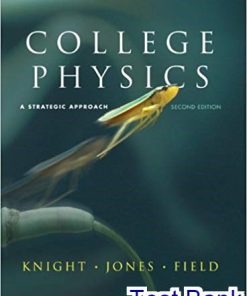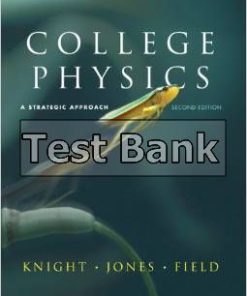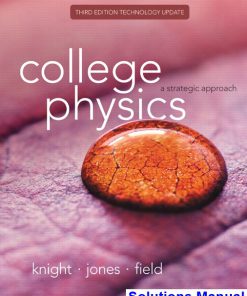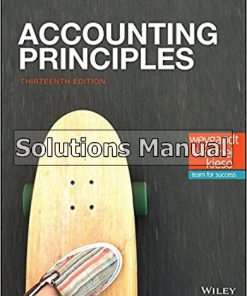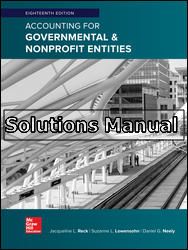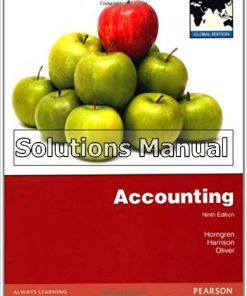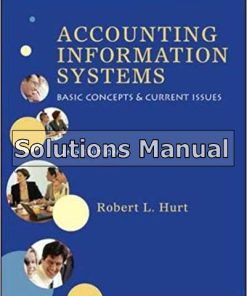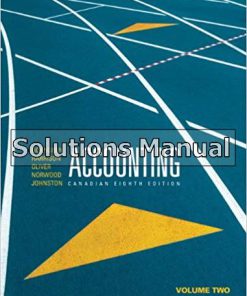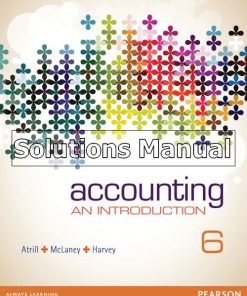College Physics A Strategic Approach 3rd Edition Knight Solutions Manual
$26.50$50.00 (-47%)
College Physics A Strategic Approach 3rd Edition Knight Solutions Manual.
You may also like
This is completed downloadable of College Physics A Strategic Approach 3rd Edition Knight Solutions Manual
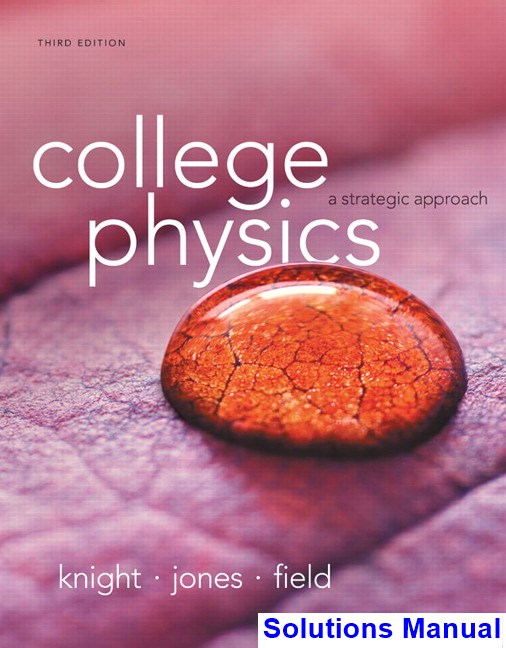
Product Details:
- ISBN-10 : 0321879724
- ISBN-13 : 978-0321879721
- Author:
Building on the research-proven instructional techniques introduced in Knight’s P hysics for Scientists and Engineers, College Physics: A Strategic Approach sets a new standard for algebra-based introductory physics—gaining widespread critical acclaim from professors and students alike. The text, supplements, and MasteringPhysics work together to help students see and understand the big picture, gain crucial problem-solving skills and confidence, and better prepare for lecture and their future.
For the Third Edition, Randy Knight, Brian Jones, and Stuart Field have incorporated student feedback and research to strengthen their focus on student learning, and to apply the best results from educational research and extensive user feedback and metadata.
Table of Content:
Preface to the Student xxvii Part I Force and Motion Overview Why Things Change 2 Chapter 1 Concepts of Motion and Mathematical Background 4 1.1 Motion: A First Look 5 1.2 Position and Time: Putting Numbers on Nature 8 1.3 Velocity 11 1.4 A Sense of Scale: Significant Figures, Scientific Notation, and Units 13 1.5 Vectors and Motion: A First Look 19 1.6 Making Models: The Power of Physics 24 1.7 Where Do We Go From Here? 25 Summary 27 Questions and Problems 28 Chapter 2 Motion in One Dimension 33 2.1 Describing Motion 34 2.2 Uniform Motion 37 2.3 Motion with Changing Velocity 43 2.4 Acceleration 45 2.5 Motion with Constant Acceleration 48 2.6 Solving One-Dimensional Motion Problems 51 2.7 Free Fall 55 Summary 60 Questions and Problems 61 Chapter 3 Vectors and Motion in Two Dimensions 70 3.1 Using Vectors 71 3.2 Using Vectors on Motion Diagrams 74 3.3 Coordinate Systems and Vector Components 77 3.4 Motion on a Ramp 82 3.5 Relative Motion 85 3.6 Motion in Two Dimensions: Projectile Motion 86 3.7 Projectile Motion: Solving Problems 89 3.8 Motion in Two Dimensions: Circular Motion 92 Summary 97 Questions and Problems 98 Chapter 4 Forces and Newton's Laws of Motion 105 4.1 What Causes Motion? 106 4.2 Force 107 4.3 A Short Catalog of Forces 110 4.4 Identifying Forces 114 4.5 What Do Forces Do? 116 4.6 Newton's Second Law 119 4.7 Free-Body Diagrams 122 4.8 Newton's Third Law 125 Summary 130 Questions and Problems 131 Chapter 5 Applying Newton's Laws 137 5.1 Equilibrium 137 5.2 Dynamics and Newton's Second Law 141 5.3 Mass and Weight 145 5.4 Normal Forces 148 5.5 Friction 150 5.6 Drag 155 5.7 Interacting Objects 159 5.8 Ropes and Pulleys 162 Summary 167 Questions and Problems 168 Chapter 6 Circular Motion, Orbits, and Gravity 175 6.1 Uniform Circular Motion 176 6.2 Speed, Velocity, and Acceleration in Uniform Circular Motion 178 6.3 Dynamics of Uniform Circular Motion 180 6.4 Apparent Forces in Circular Motion 186 6.5 Circular Orbits and Weightlessness 190 6.6 Newton's Law of Gravity 193 6.7 Gravity and Orbits 197 Summary 200 Questions and Problems 201 Chapter 7 Rotational Motion 207 7.1 The Rotation of a Rigid Body 208 7.2 Torque 211 7.3 Gravitational Torque and the Center of Gravity 215 7.4 Rotational Dynamics and Moment of Inertia 220 7.5 Using Newton's Second Law for Rotation 225 7.6 Rolling Motion 228 Summary 230 Questions and Problems 231 Chapter 8 Equilibrium and Elasticity 238 8.1 Torque and Static Equilibrium 239 8.2 Stability and Balance 243 8.3 Springs and Elastic Materials 246 8.4 Stretching, Compressing, and Bending Matter 250 Summary 255 Questions and Problems 256 Part Summary Force and Motion: Dark Matter and the Structure of the Universe 262 Part II Conservation Laws Overview Why Some Things Stay the Same 264 Chapter 9 Momentum 266 9.1 Impulse 267 9.2 Momentum and the Impulse- Momentum Theorem 268 9.3 Solving Impulse and Momentum Problems 272 9.4 Conservation of Momentum 274 9.5 Inelastic Collisions 281 9.6 Momentum and Collisions in Two Dimensions 282 9.7 Angular Momentum 283 Summary 287 Questions and Problems 288 Chapter 10 Energy and Work 295 10.1 A "Natural Money" Called Energy 296 10.2 The Basic Energy Model 297 10.3 The Law of Conservation of Energy 301 10.4 Work 305 10.5 Kinetic Energy 309 10.6 Potential Energy 313 10.7 Thermal Energy 318 10.8 Further Examples of Conservation of Energy 319 10.9 Energy in Collisions 321 10.10 Power 324 Summary 326 Questions and Problems 327 Chapter 11 Using Energy 333 11.1 Transforming Energy 334 11.2 Energy in the Body: Energy Inputs 337 11.3 Energy in the Body: Energy Outputs 339 11.4 Thermal Energy and Temperature 343 11.5 Heat and the First Law of Thermodynamics 348 11.6 Heat Engines 352 11.7 Heat Pumps 354 11.8 Entropy and the Second Law of Thermodynamics 357 11.9 Systems, Energy, and Entropy 361 Summary 362 Questions and Problems 363 Part Summary Conservation Laws: Order Out of Chaos 368 Part III Properties of Matter Overview Beyond the Particle Model 370 Chapter 12 Thermal Properties of Matter 372 12.1 The Atomic Model of Matter 373 12.2 Thermal Expansion 375 12.3 Pressure and the Kinetic Theory of an Ideal Gas 378 12.4 Ideal-Gases Processes 383 12.5 Specific Heat and Heat of Transformation 389 12.6 Calorimetry 394 12.7 Thermal Properties of Gases 396 12.8 Heat Transfer 399 Summary 405 Questions and Problems 406 Chapter 13 Fluids 414 13.1 Fluids and Density 414 13.2 Pressure 416 13.3 Measuring and Using Pressure 421 13.4 Buoyancy 425 13.5 Fluids in Motion 430 13.6 Fluid Dynamics 433 13.7 Viscosity and Poiseuille's Equation 438 Summary 441 Questions and Problems 442 Part Summary Properties of Matter: Size and Life 448 Part IV Oscillations and Waves Overview Motion That Repeats Again and Again 450 Chapter 14 Oscillations 452 14.1 Equilibrium and Oscillation 453 14.2 Linear Restoring Forces and Harmonic Motion 455 14.3 Describing Simple Harmonic Motion 458 14.4 Energy in Simple Harmonic Motion 463 14.5 Pendulum Motion 468 14.6 Damped Oscillations 470 14.7 Driven Oscillations and Resonance 473 Summary 476 Questions and Problems 477 Chapter 15 Traveling Waves and Sound 484 15.1 The Wave Model 485 15.2 Traveling Waves 486 15.3 Graphical and Mathematical Descriptions of Waves 490 15.4 Sound and Light Waves 495 15.5 Energy and Intensity 497 15.6 Loudness of Sound 500 15.7 The Doppler Effect and Shock Waves 502 Summary 507 Questions and Problems 508 Chapter 16 Superposition and Standing Waves 514 16.1 The Principle of Superposition 514 16.2 Standing Waves 516 16.3 Standing Waves on a String 518 16.4 Standing Sound Waves 523 16.5 Speech and Hearing 528 16.6 The Interference of Waves from Two Sources 530 16.7 Beats 535 Summary 538 Questions and Problems 539 Part Summary Oscillations and Waves: Waves in the Earth and the Ocean 546 Part V Optics Overview Light is a Wave 548 Chapter 17 Wave Optics 550 17.1 What is Light? 551 17.2 The Interference of Light 555 17.3 The Diffraction Grating 559 17.4 Thin-film Interference 563 17.5 Single-Slit Diffraction 567 17.6 Circular-Aperture Diffraction 571 Summary 573 Questions and Problems 574 Chapter 18 Ray Optics 580 18.1 The Ray Model of Light 581 18.2 Reflection 584 18.3 Refraction 588 18.4 Color and Dispersion 593 18.5 Image Formation by Refraction 596 18.6 Thin Lenses: Ray Tracing 597 18.7 Image Formation with Spherical Mirrors 604 Summary 608 Questions and Problems 609 Chapter 19 Optical Instruments 615 19.1 Finding the Image of a Lens or Mirror 616 19.2 The Camera 621 19.3 The Human Eye 624 19.4 The Magnifier 627 19.5 The Microscope 630 19.6 The Telescope 631 19.7 Resolution of Optical Instruments 633 Summary 639 Questions and Problems 640 Part Summary Optics: Scanning Confocal Microscopy 646 Part VI Electricity and Magnetism Overview Charges, Currents, and Fields 648 Chapter 20 Electric Forces and Fields 650 20.1 Charges and Forces 651 20.2 Charges, Atoms, and Molecules 657 20.3 Coulomb's Law 660 20.4 The Concept of the Electric Field 664 20.5 Applications of the Electric Field 667 20.6 Conductors in an Electric Field 671 20.7 Forces and Torques on Charges in Electric Fields 673 Summary 676 Questions and Problems 677 Chapter 21 Electrical Potential 684 21.1 Electric Potential Energy and the Electric Potential 685 21.2 Using The Electric Potential 689 21.3 Calculating The Electric Potential 692 21.4 Sources of Electric Potential 698 21.5 Connecting Potential and Field 700 21.6 The Electrocardiogram 704 21.7 Capacitance and Capacitors 705 21.8 Polarization and Dielectrics 708 21.9 Energy and Capacitors 710 Summary 713 Questions and Problems 714 Chapter 22 Current and Resistance 722 22.1 A Model of Current 723 22.2 Defining and Describing Current 726 22.3 Batteries and EMF 728 22.4 Connecting Potential and Current 730 22.5 Resistors and Ohm's Law 735 22.6 Energy and Power 739 Summary 742 Questions and Problems 743 Chapter 23 Circuits 749 23.1 Circuit Elements and Diagrams 750 23.2 Kirchhoff's Laws 751 23.3 Series and Parallel Circuits 754 23.4 Measuring Voltage and Current 758 23.5 More Complex Circuits 760 23.6 Household Electricity 763 23.7 Capacitors in Parallel and Series 765 23.8 RC Circuits 768 23.9 Electricity in the Nervous System 771 Summary 778 Questions and Problems 779 Chapter 24 Magnetic Fields and Forces 788 24.1 Magnetism 789 24.2 The Magnetic Field 790 24.3 Electric Currents Also Create Magnetic Fields 794 24.4 Calculating the Magnetic Field Due to a Current 798 24.5 Magnetic Fields Exert Forces on Moving Charges 803 24.6 Magnetic Fields Exert Forces on Currents 810 24.7 Magnetic Fields Exert Torques on Dipoles 814 24.8 Magnets and Magnetic Materials 818 Summary 821 Questions and Problems 822 Chapter 25 Electromagnetic Induction and Electromagnetic Waves 831 25.1 Induced Currents 832 25.2 Motional EMF 833 25.3 Magnetic Flux 837 25.4 Faraday's Law 841 25.5 Induced Fields and Electromagnetic Waves 845 25.6 Properties of Electromagnetic Waves 848 25.7 The Photon Model of Electromagnetic Waves 852 25.8 The Electromagnetic Spectrum 853 Summary 859 Questions and Problems 860 Chapter 26 AC Circuits 868 26.1 Alternating Current 869 26.2 The Transmission and Use of Electricity 872 26.3 Biological Effects and Electrical Safety 876 26.4 Capacitor Circuits 878 26.5 Inductors and Inductor Circuits 881 26.6 Oscillation Circuits 883 Summary 888 Questions and Problems 889 Part Summary Electricity and Magnetism: The Greenhouse Effect and Global Warming 894 Part VII Modern Physics Overview New Ways of Looking at the World 896 Chapter 27 Relativity 898 27.1 Relativity: What's It All About? 899 27.2 Galilean Relativity 899 27.3 Einstein's Principle of Relativity 903 27.4 Events and Measurements 906 27.5 The Relativity of Simultaneity 909 27.6 Time Dilation 911 27.7 Length Contraction 916 27.8 Velocities of Objects in Special Relativity 919 27.9 Relativistic Momentum 920 27.10 Relativistic Energy 923 Summary 927 Questions and Problems 928 Chapter 28 Quantum Physics 934 28.1 X Rays and X-Ray Diffraction 935 28.2 The Photoelectric Effect 937 28.3 Photons 944 28.4 Matter Waves 946 28.5 Energy Is Quantized 949 28.6 Energy Levels and Quantum Jumps 951 28.7 The Uncertainty Principle 954 28.8 Applications and Implications of Quantum Theory 957 Summary 960 Questions and Problems 961 Chapter 29 Atoms and Molecules 968 29.1 Spectroscopy 969 29.2 Atoms 972 29.3 Bohr's Model of Atomic Quantization 976 29.4 The Bohr Hydrogen Atom 979 29.5 The Quantum-Mechanical Hydrogen Atom 986 29.6 Multielectron Atoms 989 29.7 Excited States and Spectra 993 29.8 Molecules 997 29.9 Stimulated Emission and Lasers 999 Summary 1003 Questions and Problems 1004 Chapter 3 Nuclear Physics 1010 30.1 Nuclear Structure 1011 30.2 Nuclear Stability 1014 30.3 Forces and Energy in the Nucleus 1016 30.4 Radiation and Radioactivity 1018 30.5 Nuclear Decay Mechanisms 1025 30.6 Subatomic Particles 1028 30.7 Medical Applications of Nuclear Physics 1031 Summary 1036 Questions and Problems 1037 Part Summary Modern Physics: The Physics of Very Cold Atoms 1044 Appendix A Mathematics Review A-1 Appendix B Periodic Table of Elements A-3 Appendix C Atomic and Nuclear Data A-4 Answers to Odd-Numbered Questions A-7 Credits C-1 Index I-1
People Also Search:
college physics a strategic approach knight
college physics a strategic approach 3rd edition knight
college physics a strategic approach
college physics a strategic approach 3rd edition
college physics a strategic approach 3rd edition download scribd
college physics a strategic approach 3rd edition solution manual download pdf

